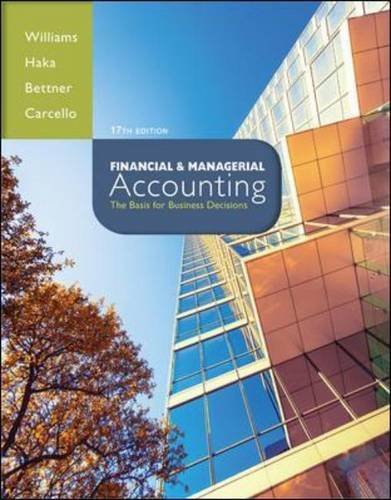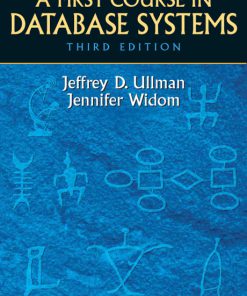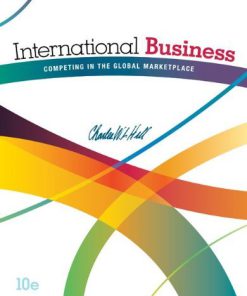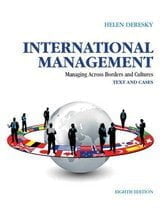Solution manual for Financial and Managerial Accounting Williams Haka Bettner Carcello 17th edition
$35.00 Original price was: $35.00.$26.50Current price is: $26.50.
Solution manual for Financial and Managerial Accounting Williams Haka Bettner Carcello 17th edition
This is completed downloadable of Solution manual for Financial and Managerial Accounting Williams Haka Bettner Carcello 17th edition

Product Details:
- ISBN-10 : 007802577X
- ISBN-13 : 978-0078025778
- Author: Jan Williams (Author), Susan Haka (Author), Mark Bettner (Author), Joseph Carcello (Author)
With the seventeenth edition of Financial and Managerial Accounting: The Basis for Business Decisions, the Williams author team continues to be a solid foundation for students who are learning basic accounting concepts. Hallmarks of the text – including the solid Accounting Cycle Presentation, relevant pedagogy, and high quality, end-of-chapter material―have been updated throughout the book.
Table of Content:
- CHAPTER 1. ACCOUNTING: INFORMATION FOR DECISION MAKING
- Accounting Information: A Means to an End
- Accounting from a User’s Perspective
- Types of Accounting Information
- Accounting Systems
- Determining Information Needs
- The Cost of Producing Accounting Information
- Basic Functions of an Accounting System
- Who Designs and Installs Accounting Systems?
- Components of Internal Control
- Financial Accounting Information
- External Users of Accounting Information
- Objectives of External Financial Reporting
- Characteristics of Externally Reported Information
- Management Accounting Information
- Users of Internal Accounting Information
- Objectives of Management Accounting Information
- Characteristics of Management Accounting Information
- Integrity of Accounting Information
- Institutional Features
- Professional Organizations
- Competence, Judgment, and Ethical Behavior
- Careers in Accounting
- Public Accounting
- Management Accounting
- Governmental Accounting
- Accounting Education
- What about Bookkeeping?
- Accounting as a Stepping-Stone
- But What about Me? I’m Not an Accounting Major
- Ethics, Fraud, & Corporate Governance
- Concluding Remarks
- End-of-Chapter Review
- Assignment Material Discussion Questions
- CHAPTER 2. BASIC FINANCIAL STATEMENTS
- Introduction to Financial Statements
- A Starting Point: Statement of Financial Position
- Assets
- Liabilities
- Owners’ Equity
- The Accounting Equation
- The Effects of Business Transactions: An Illustration
- Effects of These Business Transactions on the Accounting Equation
- Income Statement
- Statement of Cash Flows
- Relationships among Financial Statements
- Financial Analysis and Decision Making
- Forms of Business Organization
- Sole Proprietorships
- Partnerships
- Corporations
- Reporting Ownership Equity in the Statement of Financial Position
- The Use of Financial Statements by External Parties
- The Need for Adequate Disclosure
- Management’s Interest in Financial Statements
- Ethics, Fraud, & Corporate Governance
- Concluding Remarks
- End-of-Chapter Review
- Assignment Material Discussion Questions
- CHAPTER 3. THE ACCOUNTING CYCLE: CAPTURING ECONOMIC EVENTS
- The Accounting Cycle
- The Role of Accounting Records
- The Ledger
- The Use of Accounts
- Debit and Credit Entries
- Double-Entry Accounting—The Equality of Debits and Credits
- The Journal
- Posting Journal Entries to the Ledger Accounts (and How to “Read” a Journal Entry)
- Recording Balance Sheet Transactions: An Illustration
- Ledger Accounts after Posting
- What Is Net Income?
- Retained Earnings
- The Income Statement: A Preview
- Revenue
- Expenses
- The Accrual Basis of Accounting
- Debit and Credit Rules for Revenue and Expenses
- Dividends
- Recording Income Statement Transactions: An Illustration
- The Journal
- February’s Ledger Balances
- The Trial Balance
- Uses and Limitations of the Trial Balance
- Concluding Remarks
- The Accounting Cycle in Perspective
- Ethics, Fraud, & Corporate Governance
- End-of-Chapter Review
- Assignment Material Discussion Questions
- CHAPTER 4. THE ACCOUNTING CYCLE: ACCRUALS AND DEFERRALS
- Adjusting Entries
- The Need for Adjusting Entries
- Types of Adjusting Entries
- Adjusting Entries and Timing Differences
- Characteristics of Adjusting Entries
- Year-End at Overnight Auto Service
- Converting Assets to Expenses
- The Concept of Depreciation
- Converting Liabilities to Revenue
- Accruing Unpaid Expenses
- Accruing Uncollected Revenue
- Accruing Income Taxes Expense: The Final Adjusting Entry
- Adjusting Entries and Accounting Principles
- The Concept of Materiality
- Effects of the Adjusting Entries
- Concluding Remarks
- Ethics, Fraud, & Corporate Governance
- End-of-Chapter Review
- Assignment Material Discussion Questions
- CHAPTER 5. THE ACCOUNTING CYCLE: REPORTING FINANCIAL RESULTS
- Preparing Financial Statements
- The Income Statement
- The Statement of Retained Earnings
- The Balance Sheet
- Relationships among the Financial Statements
- Drafting the Notes That Accompany Financial Statements
- What Types of Information Must Be Disclosed?
- Closing the Temporary Accounts
- Closing Entries for Revenue Accounts
- Closing Entries for Expense Accounts
- Closing the Income Summary Account
- Closing the Dividends Account
- Summary of the Closing Process
- After-Closing Trial Balance
- A Last Look at Overnight: Was 2015 a Good Year?
- Financial Analysis and Decision Making
- Preparing Financial Statements Covering Different Periods of Time
- Ethics, Fraud, & Corporate Governance
- Concluding Remarks
- Supplemental Topic: The Worksheet
- Isn’t This Really a Spreadsheet?
- How Is a Worksheet Used?
- The Mechanics: How It’s Done
- What If: A Special Application of Worksheet Software
- End-of-Chapter Review
- Assignment Material Discussion Questions
- COMPREHENSIVE PROBLEM 1: Susquehanna Equipment Rentals
- CHAPTER 6. MERCHANDISING ACTIVITIES
- Merchandising Companies
- The Operating Cycle of a Merchandising Company
- Income Statement of a Merchandising Company
- Accounting System Requirements for Merchandising Companies
- Two Approaches Used in Accounting for Merchandise Inventories
- Perpetual Inventory Systems
- Taking a Physical Inventory
- Closing Entries in a Perpetual Inventory System
- Periodic Inventory Systems
- Operation of a Periodic Inventory System
- Closing Process in a Periodic Inventory System
- Comparison of Perpetual and Periodic Inventory Systems
- Selecting an Inventory System
- Transactions Relating to Purchases
- Credit Terms and Cash Discounts
- Returns of Unsatisfactory Merchandise
- Transportation Costs on Purchases
- Transactions Relating to Sales
- Sales Returns and Allowances
- Sales Discounts
- Delivery Expenses
- Accounting for Sales Taxes
- Modifying an Accounting System
- Special Journals Provide Speed and Efficiency
- Financial Analysis and Decision Making
- Ethics, Fraud, & Corporate Governance
- Concluding Remarks
- End-of-Chapter Review
- Assignment Material Discussion Questions
- CHAPTER 7. FINANCIAL ASSETS
- How Much Cash Should a Business Have?
- The Valuation of Financial Assets
- Cash
- Reporting Cash in the Balance Sheet
- Cash Management
- Internal Control over Cash
- Bank Statements
- Reconciling the Bank Statement
- Short-Term Investments
- Accounting for Marketable Securities
- Purchase of Marketable Securities
- Recognition of Investment Revenue
- Sale of Investments
- Adjusting Marketable Securities to Market Value
- Accounts Receivable
- Internal Control over Receivables
- Uncollectible Accounts
- The Allowance for Doubtful Accounts
- Writing Off an Uncollectible Account Receivable
- Monthly Estimates of Credit Losses
- Recovery of an Account Receivable Previously Written Off
- Direct Write-Off Method
- Factoring Accounts Receivable
- Credit Card Sales
- Notes Receivable and Interest Revenue
- Nature of Interest
- Accounting for Notes Receivable
- Financial Analysis and Decision Making
- Ethics, Fraud, & Corporate Governance
- Concluding Remarks
- End-of-Chapter Review
- Assignment Material Discussion Questions
- CHAPTER 8. INVENTORIES AND THE COST OF GOODS SOLD
- Inventory Defined
- The Flow of Inventory Costs
- Which Unit Did We Sell?
- Data for an Illustration
- Specific Identification
- Cost Flow Assumptions
- Average-Cost Method
- First-In, First-Out Method
- Last-In, First-Out Method
- Evaluation of the Methods
- Do Inventory Methods Really Affect Performance?
- The Principle of Consistency
- Just-in-Time (JIT) Inventory Systems
- Taking a Physical Inventory
- Recording Shrinkage Losses
- LCM and Other Write-Downs of Inventory
- The Year-End Cutoff of Transactions
- Periodic Inventory Systems
- International Financial Reporting Standards
- Importance of an Accurate Valuation of Inventory
- Techniques for Estimating the Cost of Goods Sold and the Ending Inventory
- The Gross Profit Method
- The Retail Method
- “Textbook” Inventory Systems Can Be Modified … and They Often Are
- Financial Analysis and Decision Making
- Ethics, Fraud, & Corporate Governance
- Concluding Remarks
- End-of-Chapter Review
- Assignment Material Discussion Questions
- COMPREHENSIVE PROBLEM 2: Music-Is-Us, Inc.
- CHAPTER 9. PLANT AND INTANGIBLE ASSETS
- Plant Assets as a “Stream of Future Services”
- Major Categories of Plant Assets
- Accountable Events in the Lives of Plant Assets
- Acquisitions of Plant Assets
- Determining Cost: An Example
- Some Special Considerations
- Capital Expenditures and Revenue Expenditures
- Depreciation
- Allocating the Cost of Plant and Equipment over the Years of Use
- Causes of Depreciation
- Methods of Computing Depreciation
- The Straight-Line Method
- The Declining-Balance Method
- Which Depreciation Methods Do Most Businesses Use?
- Financial Statement Disclosures
- The Impairment of Plant Assets
- Other Depreciation Methods
- The Units-of-Output Method
- MACRS
- Sum-of-the-Years’ Digits
- Decelerated Depreciation Methods
- Depreciation Methods in Use: A Survey
- Disposal of Plant and Equipment
- Gains and Losses on the Disposal of Plant and Equipment
- Trading in Used Assets for New Ones
- International Financial Reporting Standards
- Intangible Assets
- Characteristics
- Operating Expenses versus Intangible Assets
- Amortization
- Goodwill
- Patents
- Trademarks and Trade Names
- Franchises
- Copyrights
- Other Intangibles and Deferred Charges
- Research and Development (R&D) Costs
- Financial Analysis and Decision Making
- Natural Resources
- Accounting for Natural Resources
- Depreciation, Amortization, and Depletion—A Common Goal
- Plant Transactions and the Statement of Cash Flows
- Ethics, Fraud, & Corporate Governance
- Concluding Remarks
- End-of-Chapter Review
- Assignment Material Discussion Questions
- CHAPTER 10. LIABILITIES
- The Nature of Liabilities
- Current Liabilities
- Accounts Payable
- Notes Payable
- The Current Portion of Long-Term Debt
- Accrued Liabilities
- Payroll Liabilities
- Unearned Revenue
- Long-Term Liabilities
- Maturing Obligations Intended to Be Refinanced
- Installment Notes Payable
- Bonds Payable
- What Are Bonds?
- Tax Advantage of Bond Financing
- Accounting for Bonds Payable
- Bonds Issued at a Discount or a Premium
- Accounting for a Bond Discount: An Illustration
- Accounting for a Bond Premium: An Illustration
- Bond Discount and Premium in Perspective
- The Concept of Present Value
- Bond Prices after Issuance
- Early Retirement of Bonds Payable
- Estimated Liabilities, Loss Contingencies, and Commitments
- Estimated Liabilities
- Loss Contingencies
- Commitments
- Evaluating the Safety of Creditors’ Claims
- Methods of Determining Creditworthiness
- How Much Debt Should a Business Have?
- Financial Analysis and Decision Making
- Ethics, Fraud, & Corporate Governance
- Special Types of Liabilities
- Lease Payment Obligations
- Operating Leases
- Capital Leases
- Liabilities for Pensions and Other Postretirement Benefits
- Deferred Income Taxes
- Concluding Remarks
- End-of-Chapter Review
- Assignment Material Discussion Questions
- CHAPTER 11. STOCKHOLDERS’ EQUITY: PAID-IN CAPITAL
- Corporations
- Why Businesses Incorporate
- Publicly Owned Corporations
- Formation of a Corporation
- Stockholder Records in a Corporation
- Paid-In Capital of a Corporation
- Authorization and Issuance of Capital Stock
- Common Stock and Preferred Stock
- Characteristics of Preferred Stock
- Book Value per Share of Common Stock
- Market Value
- Market Price of Preferred Stock
- Market Price of Common Stock
- Book Value and Market Price
- Stock Splits
- Treasury Stock
- Recording Purchases of Treasury Stock
- Reissuance of Treasury Stock
- Stock Buyback Programs
- Financial Analysis and Decision Making
- Ethics, Fraud, & Corporate Governance
- Concluding Remarks
- End-of-Chapter Review
- Assignment Material Discussion Questions
- COMPREHENSIVE PROBLEM 3: Springdale Retail, Inc.
- CHAPTER 12. INCOME AND CHANGES IN RETAINED EARNINGS
- Reporting the Results of Operations
- Developing Predictive Information
- Reporting Irregular Items: An Illustration
- Continuing Operations
- Discontinued Operations
- Extraordinary Items
- Earnings per Share (EPS)
- Financial Analysis and Decision Making
- Other Transactions Affecting Retained Earnings
- Cash Dividends
- Dividend Dates
- Liquidating Dividends
- Stock Dividends
- Statement of Retained Earnings
- Prior Period Adjustments
- Comprehensive Income
- Statement of Stockholders’ Equity
- Stockholders’ Equity Section of the Balance Sheet
- Ethics, Fraud, & Corporate Governance
- Concluding Remarks
- End-of-Chapter Review
- Assignment Material Discussion Questions
- CHAPTER 13. STATEMENT OF CASH FLOWS
- Statement of Cash Flows
- Purposes of the Statement
- Example of a Statement of Cash Flows
- Classification of Cash Flows
- Preparing a Statement of Cash Flows
- Operating Activities
- Investing Activities
- Financing Activities
- Cash and Cash Equivalents
- Cash Flows from Operating Activities
- Cash Payments for Merchandise and for Expenses
- Cash Flows from Investing Activities
- Cash Flows from Financing Activities
- Relationship between the Statement of Cash Flows and the Balance Sheet
- Reporting Operating Cash Flows by the Indirect Method
- Reconciling Net Income with Net Cash Flows
- The Indirect Method: A Summary
- Indirect Method May Be Required in a Supplementary Schedule
- The Statement of Cash Flows: A Second Look
- Financial Analysis and Decision Making
- Managing Cash Flows
- Budgeting: The Primary Cash Management Tool
- What Priority Should Managers Give to Increasing Net Cash Flows?
- Some Strategies for Permanent Improvements in Cash Flow
- Ethics, Fraud, & Corporate Governance
- A Worksheet for Preparing a Statement of Cash Flows
- Data for an Illustration
- The Worksheet
- Entry
- Concluding Remarks
- End-of-Chapter Review
- Assignment Material Discussion Questions
- CHAPTER 14. FINANCIAL STATEMENT ANALYSIS
- Financial Statements Are Designed for Analysis
- Tools of Analysis
- Dollar and Percentage Changes
- Trend Percentages
- Component Percentages
- Ratios
- Standards of Comparison
- Quality of Earnings
- Quality of Assets and the Relative Amount of Debt
- Measures of Liquidity and Credit Risk
- A Classified Balance Sheet
- Working Capital
- Current Ratio
- Quick Ratio
- Debt Ratio
- Evaluating Financial Ratios
- Liquidity, Credit Risk, and the Law
- Measures of Profitability
- Classifications in the Income Statement
- Multiple-Step Income Statements
- Earnings per Share
- Price-Earnings Ratio
- Single-Step Income Statements
- Evaluating the Adequacy of Net Income
- Return on Investment (ROI)
- Return on Assets (ROA)
- Return on Equity (ROE)
- Comprehensive Illustration: Seacliff Company
- Analysis by Common Stockholders
- Return on Investment (ROI)
- Leverage
- Analysis by Long-Term Creditors
- Analysis by Short-Term Creditors
- Cash Flow Analysis
- Usefulness of Notes to Financial Statements
- International Financial Reporting Standards
- Summary of Analytical Measurements
- Ethics, Fraud, & Corporate Governance
- Concluding Remarks
- End-of-Chapter Review
- Assignment Material Discussion Questions
- COMPREHENSIVE PROBLEM 4: Home Depot, Inc.
- CHAPTER 15. GLOBAL BUSINESS AND ACCOUNTING
- Globalization
- Environmental Forces Shaping Globalization
- Political and Legal Systems
- Economic Systems
- Culture
- Technology and Infrastructure
- Harmonization of Financial Reporting Standards
- International Financial Reporting Standards: Adoption or Convergence
- Foreign Currencies and Exchange Rates
- Exchange Rates
- Accounting for Transactions with Foreign Companies
- Currency Fluctuations—Who Wins and Who Loses?
- Consolidated Financial Statements That Include Foreign Subsidiaries
- Global Sourcing
- Foreign Corrupt Practices Act
- Ethics, Fraud, & Corporate Governance
- Concluding Remarks
- End-of-Chapter Review
- Assignment Material Discussion Questions
- CHAPTER 16. MANAGEMENT ACCOUNTING: A BUSINESS PARTNER
- Management Accounting: Basic Framework
- Management Accounting’s Role in Assigning Decision-Making Authority
- Management Accounting’s Role in Decision Making
- Management Accounting’s Role in Performance Evaluation and Rewards
- Accounting Systems: A Business Partner
- Accounting for Manufacturing Operations
- Classifications of Manufacturing Costs
- Product Costs versus Period Costs
- Ethics, Fraud, & Corporate Governance
- Product Costs and the Matching Principle
- Inventories of a Manufacturing Business
- The Flow of Costs Parallels the Flow of Physical Goods
- Accounting for Manufacturing Costs: An Illustration
- Direct Materials
- Direct Labor
- Manufacturing Overhead
- Direct and Indirect Manufacturing Costs
- Work in Process Inventory, Finished Goods Inventory, and the Cost of Goods Sold
- The Need for Per-Unit Cost Data
- Determining the Cost of Finished Goods Manufactured
- Financial Statements of a Manufacturing Company
- Concluding Remarks
- End-of-Chapter Review
- Assignment Material Discussion Questions
- CHAPTER 17. JOB ORDER COST SYSTEMS AND OVERHEAD ALLOCATIONS
- Cost Accounting Systems
- Job Order Cost Systems and the Creation of Goods and Services
- Overhead Application Rates
- What “Drives” Overhead Costs?
- Job Order Costing
- The Job Cost Sheet
- Flow of Costs in Job Costing: An Illustration
- Accounting for Direct Materials
- Accounting for Direct Labor Costs
- Accounting for Overhead Costs
- Accounting for Completed Jobs
- Job Order Costing in Service Industries
- Activity-Based Costing (ABC)
- ABC versus a Single Application Rate: A Comparison
- Stage 1: Separate Activity Cost Pools
- Stage 2: Allocate Activity Cost Pools to the Products
- Determining Unit Costs Using ABC
- The Trend toward More Informative Cost Accounting Systems
- Ethics, Fraud, & Corporate Governance
- Concluding Remarks
- End-of-Chapter Review
- Assignment Material Discussion Questions
- CHAPTER 18. PROCESS COSTING
- Production of Goods and Services and Costing Systems
- Process Costing
- Tracking the Physical Flow and Related Production Costs
- Process Costing and Equivalent Units
- Cost per Equivalent Unit
- Tracking Costs Using a Process Costing Production Report
- Evaluating Departmental Efficiency
- Ethics, Fraud, & Corporate Governance
- Concluding Remarks
- End-of-Chapter Review
- Assignment Material Discussion Questions
- CHAPTER 19. COSTING AND THE VALUE CHAIN
- The Value Chain
- International Financial Reporting Standards and the Value Chain
- Value- and Non-Value-Added Activities
- Activity-Based Management
- Activity-Based Management across the Value Chain
- ABC: A Subset of Activity-Based Management
- The Target Costing Process
- Components of the Target Costing Process
- Target Costing: An Illustration
- Characteristics of the Target Costing Process
- Just-in-Time Inventory Procedures
- JIT, Supplier Relationships, and Product Quality
- Measures of Efficiency in a JIT System
- Total Quality Management and the Value Chain
- Components of the Cost of Quality
- Measuring the Cost of Quality
- Productivity and Quality
- Ethics, Fraud, & Corporate Governance
- Concluding Remarks
- End-of-Chapter Review
- Assignment Material Discussion Questions
- CHAPTER 20. COST-VOLUME-PROFIT ANALYSIS
- Cost-Volume Relationships
- Fixed Costs (and Fixed Expenses)
- Cost-Volume Relationships: A Graphic Analysis
- The Behavior of Per-Unit Costs
- Economies of Scale
- Additional Cost Behavior Patterns
- Cost Behavior and Operating Income
- Cost-Volume-Profit Analysis: An Illustration
- Preparing and Using a Cost-Volume-Profit Graph
- Contribution Margin: A Key Relationship
- How Many Units Must We Sell?
- How Many Dollars in Sales Must We Generate?
- What Is Our Margin of Safety?
- What Change in Operating Income Do We Anticipate?
- Business Applications of CVP
- Additional Considerations in CVP
- CVP Analysis When a Company Sells Many Products
- Determining Semivariable Cost Elements: The High-Low Method
- Assumptions Underlying Cost-Volume-Profit Analysis
- Summary of Basic Cost-Volume-Profit Relationships
- Ethics, Fraud, & Corporate Governance
- Concluding Remarks
- End-of-Chapter Review
- Assignment Material Discussion Questions
- CHAPTER 21. INCREMENTAL ANALYSIS
- The Challenge of Changing Markets
- The Concept of Relevant Cost Information
- Relevant Information in Business Decisions
- International Financial Reporting Standards and Relevant Costs
- A Simple Illustration of Relevant Costs
- Opportunity Costs
- Sunk Costs versus Out-of-Pocket Costs
- Incremental Analysis in Common Business Decisions
- Special Order Decisions
- Production Constraint Decisions
- Make or Buy Decisions
- Sell, Scrap, or Rebuild Decisions
- Joint Product Decisions
- Ethics, Fraud, & Corporate Governance
- Concluding Remarks
- End-of-Chapter Review
- Assignment Material Discussion Questions
- COMPREHENSIVE PROBLEM 5: The Gilster Company
- CHAPTER 22. RESPONSIBILITY ACCOUNTING AND TRANSFER PRICING
- Responsibility Centers
- The Need for Information about Responsibility Center Performance
- Cost Centers, Profit Centers, and Investment Centers
- Responsibility Accounting Systems
- Responsibility Accounting: An Illustration
- Assigning Revenue and Costs to Responsibility Centers
- Variable Costs
- Contribution Margin
- Fixed Costs
- Traceable Fixed Costs
- Common Fixed Costs
- Responsibility Margin
- When Is a Responsibility Center “Unprofitable”?
- Evaluating Responsibility Center Managers
- Arguments against Allocating Common Fixed Costs to Business Centers
- Transfer Prices
- Nonfinancial Objectives and Information
- Ethics, Fraud, & Corporate Governance
- Responsibility Center Reporting in Financial Statements
- International Financial Reporting Standards and Responsibility Center Reporting
- Concluding Remarks
- End-of-Chapter Review
- Assignment Material Discussion Questions
- CHAPTER 23. OPERATIONAL BUDGETING
- Profit Rich, Yet Cash Poor
- Operating Cash Flows: The Lifeblood of Survival
- Budgeting: The Basis for Planning and Control
- Benefits Derived from Budgeting
- Establishing Budgeted Amounts
- The Budget Period
- The Master Budget: A Package of Related Budgets
- Steps in Preparing a Master Budget
- Preparing the Master Budget: An Illustration
- Operating Budget Estimates
- Budgeted Income Statement
- Cash Budget Estimates
- The Cash Budget
- Budgeted Balance Sheets
- Using Budgets Effectively
- Flexible Budgeting
- Ethics, Fraud, & Corporate Governance
- Concluding Remarks
- End-of-Chapter Review
- Assignment Material Discussion Questions
- CHAPTER 24. STANDARD COST SYSTEMS
- Standard Cost Systems
- Establishing and Revising Standard Costs
- Direct Materials Standards
- Direct Labor Standards
- Manufacturing Overhead Standards
- Standard Costs and Variance Analysis: An Illustration
- Materials Price and Quantity Variances
- Labor Rate and Efficiency Variances
- Manufacturing Overhead Variances
- Valuation of Finished Goods
- Evaluating Cost Variances from Different Perspectives
- A Final Note: JIT Systems and Variance Analysis
- Ethics, Fraud, & Corporate Governance
- Concluding Remarks
- End-of-Chapter Review
- Assignment Material Discussion Questions
- CHAPTER 25. REWARDING BUSINESS PERFORMANCE
- Motivation and Aligning Goals and Objectives
- Communicating Goals and Objectives
- Accounting Information and Feedback about Goal Achievement
- Rewarding Goal Achievement
- The DuPont System
- Return on Investment
- The Components of Return on Investment
- Return on Sales
- Capital Turnover
- Criticisms of ROI
- The Short Horizon Problem
- Failing to Undertake Profitable Investments
- Measurement Problems
- Residual Income and Economic Value Added
- Residual Income
- Economic Value Added
- The Balanced Scorecard
- The Financial Perspective
- The Customer Perspective
- The Business Process Perspective
- The Learning and Growth Perspective
- Difficulties with the Balanced Scorecard
- Management Compensation
- Components of Management Compensation
- International Financial Reporting Standards and Management Compensation
- Design Choices for Management Compensation
- Goals and Rewards in Life
- Ethics, Fraud, & Corporate Governance
- Concluding Remarks
- End-of-Chapter Review
- Assignment Material Discussion Questions
- COMPREHENSIVE PROBLEM 6: Utease Corporation
- CHAPTER 26. CAPITAL BUDGETING
- Capital Investment Decisions
- Financial and Nonfinancial Considerations
- Evaluating Capital Investment Proposals: An Illustration
- Payback Period
- Return on Average Investment
- Discounting Future Cash Flows
- Replacing Assets
- Behavioral Considerations in Capital Budgeting
- Concluding Remarks
- A Comment from the Authors
- Ethics, Fraud, & Corporate Governance
- End-of-Chapter Review
- Assignment Material Discussion Questions
- APPENDIX A. HOME DEPOT 2012 FINANCIAL STATEMENTS
- APPENDIX B. THE TIME VALUE OF MONEY: FUTURE AMOUNTS AND PRESENT VALUES
- The Concept
- Relationships between Present Values and Future Amounts
- Compound Interest
- Applications of the Time Value of Money Concept
- Future Amounts
- The Tables Approach
- The Future Amount of an Annuity
- Interest Periods of Less Than One Year
- Present Values
- Using Present Value Tables
- What Is the Appropriate Discount Rate?
- The Present Value of an Annuity
- Discount Periods of Less Than One Year
- Valuation of Financial Instruments
- Interest-Bearing Receivables and Payables
- “Non-Interest-Bearing” Notes
- Market Prices of Bonds
- Capital Leases
- Obligations for Postretirement Benefits
- Assignment Material Discussion Questions
- APPENDIX C. FORMS OF BUSINESS ORGANIZATION
- Importance of Business Form
- Sole Proprietorships
- The Concept of the Separate Business Entity
- Characteristics of a Sole Proprietorship
- Unlimited Personal Liability
- Accounting Practices of Sole Proprietorships
- Evaluating the Financial Statements of a Proprietorship
- Partnerships
- General Partnerships
- Partnerships That Limit Personal Liability
- Accounting Practices of Partnerships
- Evaluating the Financial Statements of a Partnership
- Corporations
- What Is a Corporation?
- Stockholders’ Liability for Debts of a Corporation
- What Types of Businesses Choose the Corporate Form of Organization?
- Accounting for Corporate Income Taxes
- Salaries Paid to Owners
- Owners’ Equity in a Corporate Balance Sheet
- The Issuance of Capital Stock
- Retained Earnings
- Accounting for Dividends
- Closing Entries and the Statement of Retained Earnings
- Evaluating the Financial Statements of a Corporation
- The Concept—and the Problem—of “Double Taxation”
- S Corporations
- Selecting an Appropriate Form of Business Organization
- Incorporating an Established Business
- Supplemental Topic: Partnership Accounting—A Closer Look
- Opening the Accounts of a New Partnership
- Allocating Partnership Net Income among the Partners
- Assignment Material Discussion Questions
People Also Search:
financial and managerial accounting williams haka bettner carcello 17th
financial and managerial accounting williams haka bettner carcello 17th download scribd
financial and managerial accounting williams haka bettner carcello 17th solution manual download pdf
Related products
Solution Manual
Solution Manual for Data Structures and Other Objects Using C++, 4/E Michael Main, Walter Savitch
Solution Manual
Solution Manual
International Accounting Doupnik 4th Edition Solutions Manual
Solution Manual
Solution Manual
Management Information Systems Managing the Digital Firm Laudon 14th Edition Solutions Manual
Solution Manual
Solution Manual
International Business Competing in the Global Marketplace Hill 10th Edition Solutions Manual
Solution Manual











